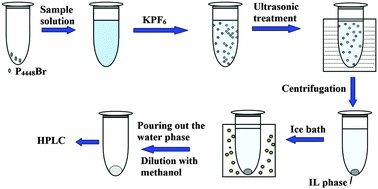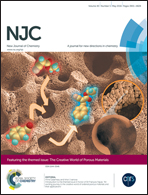Detection of triazole pesticides in environmental water and juice samples using dispersive liquid–liquid microextraction with solidified sedimentary ionic liquids
Abstract
A novel in situ metathesis reaction combined with an ultrasound-assisted dispersive liquid–liquid microextraction based on the solidification of sedimentary ionic liquids (in situ UA-SSIL-DLLME) was combined with high-performance liquid chromatography (HPLC) to detect four triazole pesticides in water and juice samples. In this method, the hydrophobic ionic liquid [P4448][PF6], formed in situ by the hydrophilic ionic liquid [P4448]Br and the anion-exchange reagent KPF6, was used as the microextraction solvent. The extraction procedure was assisted by ultrasound at 50 W for 5 min. After centrifugation and cooling, [P4448][PF6] was sedimented at the bottom and easily collected by decanting the aqueous phase directly. Various parameters affecting the extraction efficiency, such as the quantity of [P4448]Br, the molar ratio of [P4448]Br to KPF6, salt addition, ultrasound time, centrifugation rate and time, and sample pH, were evaluated. Good linearities with correlation coefficients greater than 0.99 were obtained under the optimum conditions. The limits of detection varied between 0.90 and 1.38 μg L−1, and the enrichment factors were in the range of 94–101. The recoveries of these four triazole pesticides ranged from 85.18% to 91.14%, with relative standard deviations less than 4.86% and 5.87% for intra-day (n = 3) and inter-day (n = 3), respectively. The proposed method was then successfully applied to analyze the target compounds in environmental water and juice samples.


 Please wait while we load your content...
Please wait while we load your content...